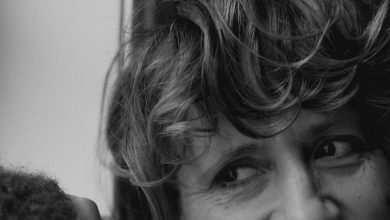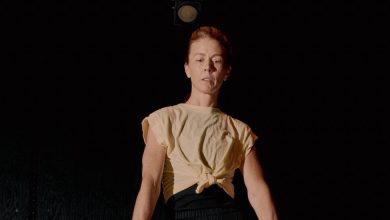Anne Imhof’s Stylish (and Shareable) Provocations

PARIS — The German artist Anne Imhof stood in the Palais de Tokyo on a recent Friday morning, watching a group of fashionably dressed dancers and models crawling on the floor. It was the final stretch of rehearsals for a series of performances she had devised, set to begin on Oct. 14. The eight young people were figuring out the right speed to cross one of the Paris museum’s expansive exhibition spaces.
Imhof, 43, towered above the crawling performers in cowboy boots and jogging pants. “Go slow, very slow,” she told them. When they reached the other side, 10 minutes later, they turned on their backs and stared at imagined spectators, with expressions of studied boredom.
“Very good,” Imhof said, looking pleased.
The rehearsals were preparation for the final act of “Natures Mortes” (“Still Lives”), a multidisciplinary exhibition by Imhof that has occupied the entirety of the Palais de Tokyo since May.
Like other Imhof shows, “Natures Mortes” includes sculptures, paintings and other works that can be visited independent of the performances. Those live presentations, which run through Oct. 24, will consist largely of tableaus formed, disrupted and then reformed by her dancers, in a production that channels the aesthetics of underground youth culture: hip clothing, industrial music, androgynous bodies.
“This piece is about death, and choice, and pain,” Imhof said in an interview before the rehearsal, “but it’s something open enough that people can have their own feelings about it.”
“With live performance, with people and bodies, I’m trying to find an abstract language that functions like poetry,” she added.
Spectators are allowed to move freely during Imhof’s performances, sometimes making them as much a part of the experience as the work itself. Because the pieces often involve multiple sequences happening simultaneously, the viewers — inevitably wielding smartphones — must make decisions on how to behave and where to move.
Much of her work, Imhof said, was about “the idea of the single individual, who can make all these connections through digitalization, but is being controlled by being tracked, and who will always be seen wherever they are.”
“The audience makes the piece what it is,” she said.
For many of the artist’s internet-savvy fans, the arresting and stylish images she creates in her performances are attractive social media fodder. Billy Bultheel, a composer who has written and performed the score for several Imhof pieces, said that audience members sometimes pushed against each other and the performers to capture the event on their phones. “Their greed for consumption is on display,” he added.
Imhof, who is warmer and funnier in conversation than her austere works might suggest, first became an art world star after winning the 2017 Golden Lion, the top prize at the Venice Biennale, for “Faust,” the German entry into the renowned art event. For that piece, she transected the pavilion, which dates from the Nazi era, with glass partitions, and surrounded the building with tall fences and guard dogs.
During performances of “Faust,” groups of dancers crawled under a glass floor, lit fires, texted on their phones and banged their heads in slow motion.
Writing in Artnet, Lorena Muñoz-Alonso described the piece as a “catwalk show from hell” that “speaks of power, of who holds it and who seeks to reclaim it.” In Artforum, David Velasco called it “a work of supremely entitled cool.” Imhof has since had high-profile exhibitions at Tate Modern in London, the National Gallery of Denmark in Copenhagen and the Art Institute of Chicago.
Carolyn Christov-Bakargiev, the director of the Castello di Rivoli, in Turin, Italy, which is currently displaying “Sex,” another exhibition by Imhof, said, “In my view, Anne is the artist who most works on how we relate to one another through separation and connection in the digital era.”
She noted that Imhof’s work embodied a shift in human interaction caused by smartphones. “Her performances represent a world where people behave as if they are in packs,” she said. “Sending each other messages, searching for each other, and trying to have real experiences.”
Christov-Bakargiev added that a “cult” had emerged around Imhof’s art, especially among digitally aware young people. “I’m not a psychoanalyst, but I think her art makes them feel that they belong and makes them understand the pain of the world,” she said.
Imhof, who is now based in Berlin, grew up in a suburb of Fulda, a midsize city in central Germany with an ornate cathedral. Her parents, an orthodontist and a teacher, were part of the “1968” generation in Germany, which pursued left-wing politics in reaction to its parents’ involvement in the Third Reich.
“It was an antifascist household,” Imhof recalled. Growing up “very much as a queer kid,” however, she said she often felt alienated from her suburban surroundings, and negotiated an escape to a British boarding school, where she first learned to draw. (She was later expelled, after being accused of smoking.)
After becoming pregnant at 20, she moved to a left-wing commune on the outskirts of Frankfurt, where she raised her daughter and began writing poetry and making music. Eventually she was accepted into the Städelschule, the city’s renowned art school, which she attended while working the door at Robert Johnson, a techno club.
She said the “artificial” experience of deciding who could and could not enter the club had helped shape her awareness of the markers that determine access to spaces and resources. “I think that’s one of the biggest issues of our time,” she said, adding that, in response, she tried to make her works “pop,” so that they resonate with as many people as possible.
Imhof’s exhibition at the Palais de Tokyo is her most expansive project yet. Since the spring, visitors have been able to see the sculptures, paintings and installations that she created for the cavernous space. Those include a labyrinth made of graffiti-daubed glass recovered from a demolished Italian office building and large-scale paintings evoking sunsets, darkened landscapes and nuclear explosions. It also includes works selected by Imhof, but made by other artists, including Sigmar Polke, Wolfgang Tillmans and Mike Kelley, and sound installations she created with Eliza Douglas, her long-term creative and romantic partner.
Douglas, who cast and styled the performers and composed the music for the Paris show, has been appearing in Imhof’s pieces since just after the couple met in 2015. A 6-foot-1 American who also models for Balenciaga, Douglas explained that Imhof’s live work was often based on a loose structure that allowed for improvisation. “She has invented her own genre within art,” Douglas said, adding that the performers often fed on the visitors’ roving attention, even if attendees occasionally overstepped their bounds.
Douglas said that dancers had confiscated audience members’ smartphones after they were thrust into their faces and that she had had to “body-check” spectators who encroached on her space. Bultheel, the composer, said that during a performance in Venice, a stranger crept up behind him and began running his fingers through his hair. “That was very awkward,” he recalled.
The reactions of the visitors at the Paris performances, Imhof said, will be impossible to predict. The show, she said, was partly influenced by the writings of Antonin Artaud, the French writer who created the “theater of cruelty,” in which artists assail the audience’s senses. Another French writer, Georges Bataille, and Franz Kafka were also influences, she said.
Sitting in the rehearsal space and staring at a floor plan, she said that the performance would include dirt bikes, a live falcon and a stuffed coyote. But she was still struggling with the logistics of a sequence in which performers would wash themselves in small pools, a cleansing ritual she said was partly inspired by the coronavirus pandemic.
“The problem with wet people is that they are wet,” she said, adding that she was worried about damaging nearby artworks, or that the audience might slip and fall. For all her provocations, she didn’t want anyone getting hurt.





